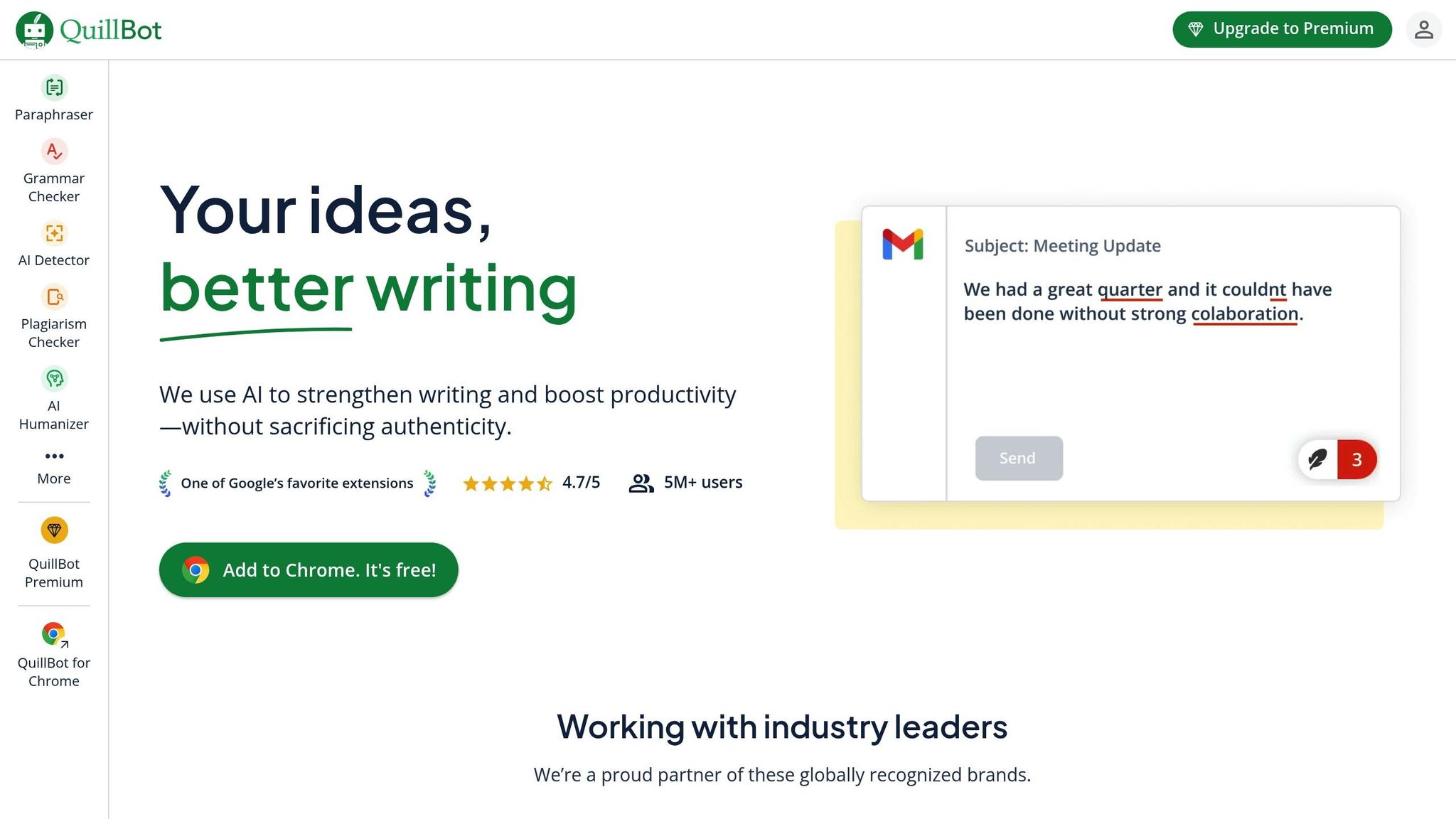Grammarly and QuillBot are two popular AI writing tools, each designed to address different writing needs. Grammarly excels in grammar accuracy, tone analysis, and style refinement, making it ideal for professionals and students who need polished, error-free communication. QuillBot focuses on paraphrasing, summarizing, and rewording, catering to students and content creators who frequently rework text or need multilingual support.
Key Takeaways:
- Grammarly: Best for grammar, tone detection, and professional writing. Premium includes plagiarism checks, advanced suggestions, and AI tools.
- QuillBot: Best for rephrasing, summarizing, and affordability. Premium removes limits on paraphrasing and includes citation tools and plagiarism detection.
Quick Comparison:
| Feature | Grammarly | QuillBot |
|---|---|---|
| Grammar Checking | Advanced | Basic |
| Paraphrasing | Limited | Multiple modes |
| Plagiarism Checker | Yes (Premium) | Yes (Premium) |
| Languages Supported | English variants | 25+ for paraphrasing |
| Free Plan | Grammar basics, AI tools | Limited paraphrasing, tools |
| Premium Cost | Higher | Lower |
Grammarly is perfect for error-free, polished writing, while QuillBot is a budget-friendly option for rewriting and summarizing. Both have free versions to try before upgrading.
I Tested QuillBot vs Grammarly for 30 Days: Here's What Happened

What Are Grammarly and QuillBot
Grammarly and QuillBot are both powerful writing tools, but they take different approaches to help users improve their writing. While both have grown into comprehensive platforms, their core strengths and purposes set them apart.
Grammarly: Key Features and Audience
Grammarly acts as an AI-driven proofreader, specializing in spotting and fixing grammar, spelling, and punctuation mistakes. Beyond basic corrections, it suggests ways to improve clarity, tone, and engagement in your writing. For those using its Premium version, Grammarly also offers tools like vocabulary suggestions, genre-specific writing style tips, and a plagiarism checker.
This platform is a go-to option for students, professionals, and non-native English speakers who want to ensure their writing is polished and impactful. It’s especially useful for marketers, content creators, authors, and business owners aiming to streamline proofreading and communicate effectively.
On the other hand, QuillBot broadens its focus, offering tools that go beyond proofreading to reshape and refine content creatively.
QuillBot: Key Features and Audience
QuillBot is designed for comprehensive writing assistance, with features like AI-powered paraphrasing, summarization, and more. It offers a variety of paraphrasing modes - including Standard, Fluency, Formal, Academic, Simple, Creative, Shorten, and Expand - along with tools like a summarizer, grammar checker, translator, plagiarism checker, and citation generator. It supports multiple languages for paraphrasing, summarizing, and translating content.
QuillBot is particularly popular among students, academics, and content creators. It’s ideal for those who need to rephrase text, condense lengthy articles, avoid plagiarism, or tailor content to specific styles, especially in academic and research settings. Its paraphrasing and citation tools are invaluable for essays, assignments, and research papers.
The difference between these tools becomes apparent when you consider how they fit into a workflow: Grammarly is like a meticulous editor focused on catching errors and refining style, while QuillBot acts as a creative collaborator, helping users rework and summarize content with ease.
Grammar and Style Features Compared
When it comes to writing tools, Grammarly and QuillBot take different approaches to grammar checking and style refinement. Knowing their strengths can help you decide which one suits your writing needs best.
Grammar Checking Performance
Grammarly stands out as a thorough grammar checker, designed to catch everything from simple typos to intricate punctuation errors. Its AI engine dives deep into sentence structure, pinpoints mistakes, and explains corrections. This makes it a great fit for formal business writing or professional documents.
QuillBot, on the other hand, offers a more basic level of grammar checking. While its functionality is simpler, it’s effective for quick fixes and naturally ties into its stylistic adjustments.
Style Help and Tone Detection
Grammarly's Premium version goes beyond grammar, analyzing tone, suggesting better word choices, and offering tips tailored to specific genres. Its real-time feedback on clarity, engagement, and delivery is particularly useful for professionals aiming to keep their communication polished and effective.
QuillBot approaches style differently by focusing on structural changes through its paraphrasing tool instead of dedicated tone analysis. With various paraphrasing modes, users can tweak their writing style to fit different contexts. While tone detection isn’t its strength, QuillBot’s emphasis on rewriting offers a unique way to refine content.
Paraphrasing and Rewriting Tools
QuillBot shines in the paraphrasing department, offering modes like Humanize and Creative to rework sentences while keeping their original meaning intact.
"Whenever I struggle to find the perfect phrasing, I use their paraphrasing tool, allowing me to generate unique sentences while maintaining the same context and meaning." – Daniel Völk, Published author
Grammarly, on the other hand, incorporates sentence rewriting into its Pro plans, providing suggestions to improve clarity, flow, and overall readability. It even offers first drafts, summaries, and templates to streamline the writing process. Its suggestions help users write with purpose and address potential reader concerns.
"Whole sentence rewrites are where the AI can shine. With prompts on how to combine sentences with related ideas, improve paragraph flow and make your writing sound clearer in general." – The Mind Collection
"Your periodical reminder that Grammarly is not infallible. The more complex the sentence and context, the more difficult it is for the AI to make the right call." – The Mind Collection
While QuillBot focuses on flexible paraphrasing options, Grammarly’s rewriting tools are part of a broader suite designed to enhance clarity, tone, and overall communication.
Plagiarism Detection and Extra Tools
Grammarly’s Premium plagiarism checker is a standout feature, scanning billions of sources and offering detailed citation reports. This makes it indispensable for academic and professional settings.
QuillBot also includes plagiarism detection but pairs it with additional tools like summarization, translation, and citation generation. It supports formats like APA, MLA, and Chicago, making it a practical choice for academic work.
Grammarly, however, leans heavily into the writing and editing process, offering vocabulary suggestions, genre-specific tips, and generative AI features. Depending on the plan, users can access everything from 100 AI prompts in the free version to unlimited prompts in Enterprise subscriptions.
Pricing and Plans
When choosing between Grammarly and QuillBot, it's essential to weigh their pricing structures against your budget and the features you need. Both platforms offer free versions with the option to upgrade to premium, but their pricing strategies and included features vary quite a bit.
Free vs Premium Features
Grammarly's free version focuses on essentials like grammar, spelling, and punctuation checks. It also includes tone detection and 100 AI prompts per month, making it a practical choice for casual writers who need basic writing assistance.
QuillBot's free tier, on the other hand, spreads its features across multiple tools. It allows for paraphrasing up to 125 words, summarizing up to 1,200 words, translating up to 5,000 words, and comes with 50 AI prompts per day. While it grants access to most tools, the plagiarism checker is reserved for premium users.
The premium upgrades reflect each platform's priorities. Grammarly Premium offers unlimited plagiarism checks (within fair usage limits), advanced grammar and style suggestions, tone adjustments, and an expanded AI prompt allowance of 1,000 per month. This makes it a comprehensive solution for professionals who need in-depth editing.
QuillBot Premium, meanwhile, removes word limits on paraphrasing and enhances its tools, making it especially useful for students and content creators who frequently need to rephrase or refine text. It also includes a plagiarism checker, adding an extra layer of content validation.
Subscription Plans and Costs
Both Grammarly and QuillBot offer flexible subscription options, including monthly and annual plans. Generally, QuillBot's premium plan is more budget-friendly. Opting for an annual subscription can often save you money compared to paying monthly, so your choice might depend on how you prefer to manage your expenses.
Grammarly's premium features cater to professionals seeking comprehensive editing and writing support, while QuillBot's more affordable plan is ideal for students and creators focused on paraphrasing and content refinement.
In the end, your choice should align with your primary needs and budget. Grammarly is a solid pick if you need advanced grammar tools and professional editing features. On the other hand, QuillBot offers excellent value for those who prioritize paraphrasing, research, and affordability.
Next, we’ll dive into user experience and integrations to round out the comparison.
sbb-itb-212c9ea
User Experience and Integrations
US English Support
Grammarly provides dedicated support for American English through its account settings, ensuring its suggestions align with U.S. spelling, grammar, and punctuation standards. The platform also acknowledges the nuances of other English variants, such as British, Canadian, Australian, and Indian English.
"Grammarly also recognizes a number of spelling, grammar, and punctuation differences in American, British, Canadian, Australian, and Indian English."
On the other hand, QuillBot takes a more flexible approach to English dialects. While it doesn’t offer a specific setting for American English, its Grammar and Translation tools adapt to various English variants. Its paraphrasing modes are designed to refine text into clear, polished English.
"Effortlessly transform your thoughts into natural, polished English."
This distinction highlights how each tool caters to different user needs. Grammarly’s precise settings are ideal for those requiring strict adherence to American English conventions in professional or academic contexts. Meanwhile, QuillBot’s adaptable features make it a great choice for general English refinement across multiple dialects.
How to Choose the Right Tool
Best Tool for Different Users
Choosing the right writing assistant depends on your specific needs and challenges. Here's a breakdown of how different users can benefit from Grammarly and QuillBot:
- Students and academics: Grammarly is a strong choice for tackling research papers and essays. Its detailed grammar checks and plagiarism detection tools help maintain academic integrity, while its explanations aid in improving writing skills over time.
- Content creators and marketers: QuillBot shines for repurposing and paraphrasing content quickly. With multiple paraphrasing modes, users can tweak tone and style to suit various audiences, whether for social media posts or marketing campaigns.
- Professional writers and business professionals: Grammarly offers advanced style suggestions and tone detection, making it ideal for tailoring content to different audiences and maintaining consistency in corporate communication.
- ESL learners: Grammarly’s detailed explanations provide helpful context for corrections, while QuillBot’s paraphrasing feature offers alternative ways to phrase ideas, making it easier to express yourself when language barriers arise.
Once you’ve identified which tool aligns with your needs, the next step is to consider features and budget.
Feature Needs and Budget Planning
Your primary writing challenges will guide your choice between Grammarly and QuillBot. If you're focused on grammar accuracy, Grammarly’s premium plan delivers top-notch error detection and detailed explanations. On the other hand, if paraphrasing and rewording are your priorities, QuillBot’s premium subscription offers efficient and cost-effective solutions.
For those on a tighter budget, both tools offer free versions to get started. Grammarly’s free plan covers basic grammar checks, while QuillBot’s free tier provides limited paraphrasing capabilities. Testing these free options can help you decide which tool best meets your needs before committing to a paid plan.
Find More AI Writing Tools
If Grammarly and QuillBot don’t fully meet your requirements, there are plenty of other AI writing tools to explore. The AI Apps directory is a great resource, offering advanced filtering options to search by budget, features, and use case. Whether you’re looking for tools tailored to technical writing, creative projects, or multilingual support, this directory makes it easy to compare pricing, read user reviews, and discover the perfect solution for your workflow.
Conclusion
Grammarly and QuillBot each bring their own strengths to the table, catering to different aspects of the writing process. Grammarly shines as a robust grammar and style checker, offering detailed feedback on errors, tone, and even plagiarism. This makes it an excellent choice for professionals, students, and anyone who values precise and polished communication.
On the other hand, QuillBot stands out for its paraphrasing capabilities, offering various rewriting modes that are especially helpful for content creators, marketers, and those who frequently need to rework existing text. Its focus is on rephrasing and idea expression rather than deep grammar correction, making it a practical and budget-friendly option for specific writing tasks.
Grammarly’s premium plans come at a higher cost, reflecting its extensive range of features, while QuillBot provides more affordable premium options tailored for users primarily interested in paraphrasing and rewriting.
Choosing between the two depends on your writing priorities. If grammar accuracy, tone analysis, or plagiarism detection are your main concerns, Grammarly is the tool for you. If your needs center on rephrasing content, overcoming writer’s block, or staying within a tighter budget, QuillBot is a better fit.
Both tools offer free trials, so you can explore their core features and decide which one aligns best with your workflow. And for those with specialized needs, platforms like AI Apps can help you discover other writing tools designed to meet unique challenges and budgets.
FAQs
How do Grammarly and QuillBot differ in grammar checking and style refinement?
Grammarly stands out for its grammar and style-checking features, making it an excellent choice for producing clear, error-free writing. It’s particularly effective at spotting tricky grammar mistakes, refining sentence structure, and improving overall readability.
QuillBot, in contrast, shines when it comes to paraphrasing and reworking sentences, making it a useful tool for rewriting content or finding alternative ways to phrase ideas. However, its grammar and style-checking capabilities don’t match the depth offered by Grammarly.
If your priority is thorough grammar corrections and style polishing, Grammarly is the way to go. But if you need help with rewriting or paraphrasing, QuillBot is better suited for the job.
How do Grammarly and QuillBot compare in pricing and features, and which is better for students?
Grammarly and QuillBot serve different purposes, each excelling in specific areas to meet students' varied needs. Grammarly shines with its advanced grammar checks, style improvement tips, and plagiarism detection, making it perfect for students who want polished, error-free writing. Its premium plan starts at $12.00 per month when paid annually.
QuillBot, however, focuses on paraphrasing and summarizing, offering a more budget-friendly option at $8.33 per month (billed annually). This makes it particularly useful for students who need help rewording or condensing content.
If you're looking for all-around writing assistance, Grammarly offers more extensive support. But for targeted tasks like paraphrasing, QuillBot provides an affordable and effective alternative.
When would QuillBot be a better choice than Grammarly for academic or content creation tasks?
QuillBot shines when it comes to academic and content creation tasks, offering tools like advanced paraphrasing, citation generation, and support for rewriting and polishing ideas. It’s especially handy for rephrasing text effectively, making it a go-to choice for simplifying complex concepts or crafting original content.
While Grammarly is known for its strong focus on grammar and clarity, QuillBot caters more to users needing creative or research-oriented writing support. Features like citation assistance and improving the flow of text make it particularly suited for essay writing, drafting research papers, or producing distinct content.



